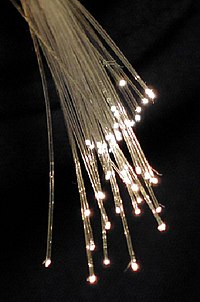
Photo from wikipedia
Magnetoelectric thin-film cantilevers consisting of strain-coupled magnetostrictive and piezoelectric layers are promising candidates for magnetic field measurements in biomedical applications. In this study, we investigate magnetoelectric cantilevers that are electrically… Click to show full abstract
Magnetoelectric thin-film cantilevers consisting of strain-coupled magnetostrictive and piezoelectric layers are promising candidates for magnetic field measurements in biomedical applications. In this study, we investigate magnetoelectric cantilevers that are electrically excited and operated in a special mechanical mode with resonance frequencies above 500 kHz. In this particular mode, the cantilever bends in the short axis, forming a distinctive U-shape and exhibiting high-quality factors and a promising limit of detection of 70pT/Hz1/2 at 10 Hz. Despite this U mode, the sensors show a superimposed mechanical oscillation along the long axis. The induced local mechanical strain in the magnetostrictive layer results in magnetic domain activity. Due to this, the mechanical oscillation may cause additional magnetic noise, deteriorating the limit of detection of such sensors. We compare finite element method simulations with measurements of magnetoelectric cantilevers in order to understand the presence of oscillations. From this, we identify strategies for eliminating the external effects that affect sensor operation. Furthermore, we investigate the influence of different design parameters, in particular the cantilever length, material parameters and the type of clamping, on the amplitude of the undesired superimposed oscillations. We propose design guidelines to minimize the unwanted oscillations.
Journal Title: Sensors
Year Published: 2023
Link to full text (if available)
Share on Social Media: Sign Up to like & get
recommendations!